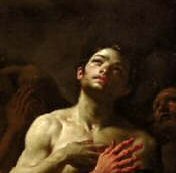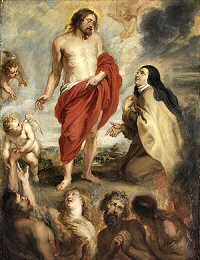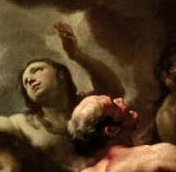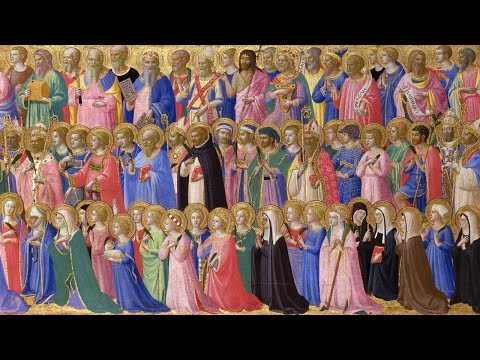At the end of the Synod General Assembly, Congolese Cardinal Fridolin Ambongo tells Vatican News that synodality is a “reflection on a new way of being Church” which highlights the importance of listening to the Holy Spirit and each other without neglecting the essentials of the Catholic faith.
By Stanislas Kambashi, SJ
At the end of the first session of the 16th Ordinary General Assembly of the Synod of Bishops, the Cardinal Archbishop of Kinshasa has expressed his satisfaction with the synodal process.
In the following interview with Vatican News, Cardinal Fridolin Ambongo Besungu, President of the Symposium of Episcopal Conferences of Africa and Madagascar (SECAM), also commented on the final Synthesis Report, the involvement of the African Church, and the meaning of synodality for the future of the Church.
Q: How would you describe your experience at the end of this Synod?
At the end of this Synod, I feel first and foremost a feeling of gratitude to the Lord who allowed me to have this exceptional experience. This is the fourth Synod I have participated in, but I must say that this Synod on synodality has been exceptional.
Q: In what way was it exceptional?
First, it was exceptional in its composition. It is called a Synod of Bishops, but we were not only bishops. There were lay people, women, youth, delegates from sister Churches, and it created an unusual atmosphere. Another fact is that we were twice as many as usual. Instead of meeting in the new Synod Hall, we held our sessions in the Paul VI Hall.
But I must say that what characterized this Synod the most was the method used, the method of conversation in the Spirit, meetings, exchanges interspersed with moments of prayer, meditation, silence, which has never before been the case. And it really put us in the condition of listening to the Holy Spirit while also listening to one another.
Q: How did you actively participate in this synodal assembly? What is this Synod bringing to the Church or can bring to the life of the Church?
In my analysis, this Synod opens up new perspectives for our Church. It is a Synod, as its name suggests, on synodality. This means that the Church has become aware that something needs to change in its way of being.
The Synod on synodality is about seeking together, about listening to the Holy Spirit today to become a different Church, while retaining the essence of what makes it the Church. In other words, it is about seeking together how we can hold hands and walk together guided by the Holy Spirit to become a different Church, a Church that does not leave anyone on the sidelines but addresses the major pastoral challenges that arise, a Church that listens to one another and to the Holy Spirit.
This kind of Synod will inevitably lead to individual conversion but also to collective conversion as a Church. This Synod will radically change the way the Church operates and exists.
Q: You are one of the drafters of the synthesis report, the first step towards a possible post-synodal Exhortation. What value and what importance should be given to this text? Is it only a text that should accompany the Church until the next session in October 2024?
The synthesis report that we have just adopted has two intended recipients. The first is the people of God who saw us locked up in Rome, at the Vatican, for a month. They have the right to know what we have done, what we have talked about, what the result of this month-long meeting was. We have taken care to inform the people about what happened through this content.
But the second recipient is us, who participated in the first session of the Synod. This document will help us go through this period, from now until October 2024, and prepare for the second session. However, this document is transitional. It is not the final document of the Synod yet because there is still the second session.
But it is a transitional document to help us live through this transitional period, to better inform the people of God about what happened, and also with the hope that when we return for the second session, we will bring new elements to enrich the discussions.
Q: Do you think the Synod has addressed all the questions that were planned, or were there some questions that could not be addressed?
I would like to be clear on this point. This Synod had a goal: it is a Synod on synodality, as in the past there have been Synods on youth, on the family, etc.
This Synod is about reflecting before God in prayer, listening to the Holy Spirit, listening to our brothers and sisters, to reflect on the new way of being Church, a Church that listens, a Church that does not leave anyone on the sidelines, but a Church that advances toward the Kingdom of God, which is the central theme of Jesus' preaching.
So, coming to this Synod, the intention was not to address this or that problem. The main intention, the primary objective of the Synod, is about how we can become a new Church together, acquire a new way of being the Church; in our way of being, in our operating structures, in our collaboration structures.
How can we learn to be a Church that is open to all but does not abandon anything essential to the Catholic faith? Therefore, it is about reflecting on our new way of being the Church. Each participant spoke about the issues that concerned them, the pastoral challenges. We discussed many questions, but these questions were not at the center of our reflection. That's why in the document, the synthesis report, we address the questions in three parts. First, for each pastoral challenge, we see the point of convergence that emerged in the hall.
Then, there are points to deepen. This means that the Synod leaves the subject open because there is still the second session. The third part consists of some proposals to help us progress on the path of synodality. For each theme addressed, there is this cadence: convergences, open questions, what remains to be done. And possible proposals.
Q: The Synod brought together participants from the universal Church. Each certainly made their contribution. What was the contribution of the Church in Africa, in your opinion?
The Church in Africa has made a substantial contribution, perhaps not in the way that journalists would like when they ask the question, saying that we did not hear the voice of the Church in Africa. No, we did not come to this Synod with the spirit of claims, with a parliamentary spirit, as the Pope emphasized at the beginning.
We are not African parliamentarians who came to an assembly to represent Africa. We are sons and daughters of the universal Church, but we experience pastoral challenges that are sometimes unique to us or challenges that are experienced differently elsewhere, with a particular emphasis on Africa, and these are the challenges we brought.
During the Synod, we tried to address some of these challenges, especially the suffering of our people. The African continent is a place where there are many unhappy and poor people, and the result is that young people only dream of leaving because life becomes impossible in Africa. There is the challenge of climate change. Africa is the continent that pollutes the least but suffers more from the consequences of climate change. There is the challenge of the mismanagement of our countries, with coups d'état, with political leaders who only think of their personal enrichment, etc. So we tried to share these concerns with our brothers and sisters from other continents so that, in the spirit of synodality, we can together seek ways to help this continent emerge from its misery.
So we can say that the voice of Africa was heard in the Synod Hall. Certainly. We were a delegation of more than sixty people, and we spoke, we fulfilled our role. But I want to reiterate that we did not do this with the intention of distinguishing ourselves from others. No, we addressed all these questions, even if they were specific to Africa, and we even mentioned the issue of polygamy and others that are specific to Africa, but in a spirit of synodality.
Q: What can the Church in Africa expect from this Synod? You have brought its voice, and in return, at the local level, in the particular Churches, in African societies, what can Africans expect?
First of all, we must recognize that the Synod is not yet over. We are now finishing the first session. This is why the document that came out of this session is a transitional document. Next year, in October, we will return for the second session. It is then that the Pope will issue a post-synodal exhortation, and that document will be authoritative. In the meantime, upon returning to our countries and our Churches, all those who participated in this Synod are encouraged to consider themselves as missionaries, to report back, to share the synodal experience of this experience of communion, of fraternity that we lived together for a month, with our brothers and sisters.
So, when I return to Kinshasa, I will first report what we have experienced and try to convince others to come and have the same experience with us. This joy, this happiness of living as brothers and sisters, as members of the same family, the large family of the children of God. So, what we will share with the people in return is first our own experience, and then, share the content of the synthesis report.
Q: Have you thought of a method of reporting back to people, or will it only be done through homilies? Will there be other frameworks for this restitution?
We have thought of a method of restitution because, as you can see, not all the dioceses in Africa were represented at this Synod. For the Democratic Republic of Congo, which has forty-eight dioceses, we had only three bishops. So, the restitution, first for me as the Archbishop of Kinshasa, will be at the level of my diocese.
The next phase is at the national level. We will meet as bishops of Congo within the framework of the Cenco to reflect on the Synthesis Report, but also to share our experience of synodality during our stay in Rome with our brothers in the episcopate. I believe that after this meeting, the Congolese episcopate will provide some guidelines to the entire Church in Congo for the reception of the document. It will also provide better understanding and guidance to implement the elements already available in this document.
Beyond the national level, there is also the continental level. We have already planned for the third week after Easter next year, in April, a continental meeting with all those who participated in this Synod, and possibly new members. If the Holy Father wants to add new members, we will invite them all so that at the continental level, we can share our experience and our hopes, our proposals for the second phase to be held here in Rome in 2024.
Q: Any final thoughts?
I am satisfied to have participated in this experience. And it is with joy and gratitude that I return to my diocese after having had this experience, which, for me, is a new experience, an experience of a Church that walks together, that cares for all its sons and daughters, a Church that listens to one another, but that mainly listens to the Holy Spirit.
 Purgatory is not eternal. Its duration varies according to the sentence pronounced at each particular judgment. It may be prolonged for centuries in the case of the more guilty souls, or of those who, being excluded from the Catholic communion, are deprived of the suffrages of the Church, although by the divine mercy they have escaped hell. But the end of the world, which will be also the end of time, will close forever the place of temporary expiation. God will know how to reconcile His justice and His goodness in the purification of the last members of the human race, and to supply by the intensity of the expiatory suffering what may be wanting in duration. But, whereas a favourable sentence at the particular judgment admits of eternal beatitude being suspended and postponed and leaves the bodies of the elect to the same fate as those of the reprobate; at the universal judgment, every sentence, whether for heaven or for hell, will be absolute, and will be executed immediately and completely.
Purgatory is not eternal. Its duration varies according to the sentence pronounced at each particular judgment. It may be prolonged for centuries in the case of the more guilty souls, or of those who, being excluded from the Catholic communion, are deprived of the suffrages of the Church, although by the divine mercy they have escaped hell. But the end of the world, which will be also the end of time, will close forever the place of temporary expiation. God will know how to reconcile His justice and His goodness in the purification of the last members of the human race, and to supply by the intensity of the expiatory suffering what may be wanting in duration. But, whereas a favourable sentence at the particular judgment admits of eternal beatitude being suspended and postponed and leaves the bodies of the elect to the same fate as those of the reprobate; at the universal judgment, every sentence, whether for heaven or for hell, will be absolute, and will be executed immediately and completely. The Church Suffering and the Church Militant constitute in their relations a second circle of most vital activities. Having entered into the night "wherein no man can work," the Suffering Church cannot ripen to its final blessedness by any efforts of its own, but only through the help of others—through the intercessory prayers and sacrifices (suffragia) of those living members of the Body of Christ who being still in this world are able in the grace of Christ to perform expiatory works. The Church has from the earliest times faithfully guarded the words of Scripture that it is a holy and a wholesome thing to pray for the dead that they may be loosed from their sins. [2 Macab. 12, 43] The suppliant cry of her liturgy: "Eternal rest give to them, O Lord, and let perpetual light shine upon them," can be heard already in the Acts of the martyrdom of SS. Perpetua and Felicitas (A.D. 203) and is represented in numerous sepulchral inscriptions of the most ancient period, while theologians and Fathers of the Church, beginning with Tertullian, have supplied its substantial proof. . . . So fundamental indeed and so natural to man's hope and desire and love is this belief, that historians of religion have discovered it among almost all non-Christian civilized peoples: a striking illustration of Tertullian's saying that the human soul is naturally Christian.
The Church Suffering and the Church Militant constitute in their relations a second circle of most vital activities. Having entered into the night "wherein no man can work," the Suffering Church cannot ripen to its final blessedness by any efforts of its own, but only through the help of others—through the intercessory prayers and sacrifices (suffragia) of those living members of the Body of Christ who being still in this world are able in the grace of Christ to perform expiatory works. The Church has from the earliest times faithfully guarded the words of Scripture that it is a holy and a wholesome thing to pray for the dead that they may be loosed from their sins. [2 Macab. 12, 43] The suppliant cry of her liturgy: "Eternal rest give to them, O Lord, and let perpetual light shine upon them," can be heard already in the Acts of the martyrdom of SS. Perpetua and Felicitas (A.D. 203) and is represented in numerous sepulchral inscriptions of the most ancient period, while theologians and Fathers of the Church, beginning with Tertullian, have supplied its substantial proof. . . . So fundamental indeed and so natural to man's hope and desire and love is this belief, that historians of religion have discovered it among almost all non-Christian civilized peoples: a striking illustration of Tertullian's saying that the human soul is naturally Christian. By the practice of Indulgences, the Church places at the charitable disposal of the faithful the inexhaustible treasure accumulated, from age to age, by the superabundant satisfactions of the saints, added to those of the martyrs, and united to those of our Blessed Lady and the infinite residue of our Lord's sufferings. These remissions of punishment she grants to the living by her own direct power; but she nearly always approves of and permits their application to the dead by way of suffrage, that is to say, in the manner in which, as we have seen, each of the faithful may offer to God who accepts it, for another, the suffrage or succour of his own satisfactions.
By the practice of Indulgences, the Church places at the charitable disposal of the faithful the inexhaustible treasure accumulated, from age to age, by the superabundant satisfactions of the saints, added to those of the martyrs, and united to those of our Blessed Lady and the infinite residue of our Lord's sufferings. These remissions of punishment she grants to the living by her own direct power; but she nearly always approves of and permits their application to the dead by way of suffrage, that is to say, in the manner in which, as we have seen, each of the faithful may offer to God who accepts it, for another, the suffrage or succour of his own satisfactions.



